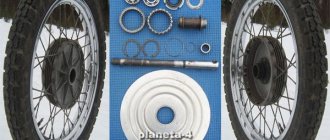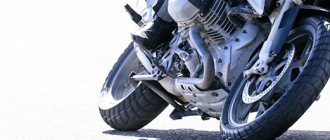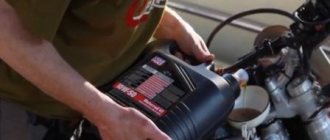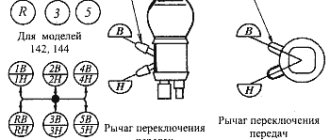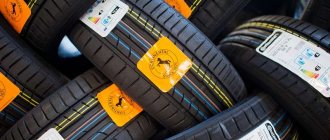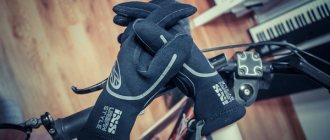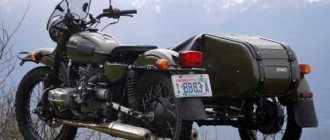To improve tire performance, increase engine efficiency, and ensure road stability, it is necessary to maintain the correct tire pressure. They are designed in such a way that their shape must be maintained by internal pressure. If a tire is inflated correctly, it wears evenly and there is no deformation of the tread or sidewall of the tire.
An overinflated tire has a smaller contact patch, which negatively affects directional stability, especially when cornering. The center portion of the tread will experience the most wear. The tire becomes very rigid and transfers vibrations from bumps on the road more strongly to the body of the scooter. The suspension suffers: bearings and silent blocks, as well as shock absorbers.
If the tire is underinflated, then the grip on the road is also insufficient, wear occurs on the side parts of the tread. Due to increased friction, the tire overheats, which leads to the destruction of the carcass. A 20% lack of pressure results in a 30% reduction in tire service life. In addition, rolling resistance increases, resulting in increased fuel consumption.
Therefore, the pressure must be maintained at the recommended level. If the tire fits well to the rim and has no punctures, then it practically does not deflate. However, the pressure must sometimes be checked, at least visually. If you get on a scooter and the tire is noticeably deformed, it means that it urgently needs to be inflated.
To measure pressure, instruments called pressure gauges are used. They can be mechanical (pointer) or digital electronic. Pressure gauges built into compressors are usually not very accurate. But they are suitable for a scooter.
To how many atmospheres should a scooter wheel be inflated?
The following figures are usually used: the front wheel of a scooter is inflated to 1.8 atm, and the rear wheel - to 2 atm. In winter, the pressure can be reduced by 0.1-0.2 atm.
You should always inflate a “cold” tire, that is, after a long period of inactivity, since when driving it heats up and the pressure increases.
Please note: This article and the images in it are subject to copyright. Partial or complete reproduction on other resources without permission is prohibited.
Source scooter777.ru
The importance of maintaining correct tire pressure
how to measure it, how often to pump it up, what consequences can there be when driving a scooter on flat tires? These basic rules are important to know, although we often do not attach much importance to them.
Theory and practice
We all know that when air is heated, it expands, and when it cools, it occupies less volume. In order to determine what pressure a motorcycle tire should be, it is necessary to clearly determine how the vehicle will be used. Two identical tires, after active driving, may show different pressures, which is associated with warming up the air. Braking, asphalt temperature, and dynamic friction of the tire surface heat up the front and rear wheels differently.
To determine what motorcycle tire pressure is necessary for efficient and safe riding, you can use the following rules:
- Use the documentation and technical manuals that came with your motorcycle. Each manufacturer, in order to carry out certification, conducts a comprehensive assessment of the characteristics of its vehicle based on the results of tests and conclusions. As a result, a mark is placed in the technical passport or manual about the recommended pressure in the tires of the front and rear wheels.
- If you approach the motorcycle from behind, there should be a tire pressure recommendation mark on the swingarm arm. The motorcycle tire pressure table is given below:
in English/Japanese – front wheel 120 / 60 R17 2.0 in English/Japanese – rear wheel 180 / 55 R17 2.9 - Make your own assessment of ride quality at different pressures and determine the best indicator.
The tire pressure on a Minsk motorcycle may not match the pressure on sports or motocross bikes. For example, the average for motorcycles weighing up to 150 kg (without a pilot) should be: 2-2.2 ATM in the front wheel, 2.4-2.6 in the rear .
If you load your work motorcycle and move with a passenger, then the pressure can be increased to 2.6-2.9 Atm. On average, the correction per passenger should be about 0.2 Atm. Conversely, the pressure in the tires of a motocross motorcycle should be reduced when entering the track before active riding.
Correctly set pressure will not only reduce fuel consumption and extend their service life, but will also dramatically increase the controllability of the motorcycle at high speeds, when turning or overtaking.
Tires for a scooter
Scooter tires are one of the most important consumable items responsible for the safety of the vehicle driver on the road. The choice of motorcycle tires for a scooter is extremely important, despite the fact that they are not purchased very often. Tires for scooters provide a level of comfort for the driver during the trip, good handling and stability of the vehicle. In the motorcycle tire market, the most widespread are Chinese-made motorcycle tires, followed by Taiwanese-made models. In addition, every year Chinese auto and motor tires are increasingly replacing expensive European models.
Scooter tires
The choice of motor tires, which is presented on the domestic market, is as follows:
- KENDA are motorcycle tires for scooters made in Taiwan, extremely popular among motorcycle enthusiasts. The so-called “herringbone” tires are especially popular, i.e., Kenda model motorcycle tires with two treads, as well as a model with one tread resembling a pattern of wavy lines. The latter type of tires is perfect for asphalt and smooth city roads. According to the advice of experienced motorcyclists, it is not recommended to use tires with an aggressive tread pattern in urban conditions, since during movement the tread blocks cling to the asphalt quite strongly, creating increased resistance and excessive vibrations. But at the same time, these motorcycle tires are indispensable for country and dirt roads, which is especially noticeable when they are installed on the front wheels.
- DURO are scooter tires made in China, which are distinguished by fairly high quality indicators and a fairly affordable price. But when using them on wet roads, it is imperative to take increased precautions due to their high rigidity.
- PIRELLI - Italian-made motor tires.
- MICHELIN - French tires of fairly high quality.
- METZELER - have a high level of softness and stability on the road, and are also durable and suitable for any road.
- The DUNLOP and BRIDGESTONE brands represent motorcycle tires made in Japan, which are installed at manufacturing plants on the wheels of Japanese motorcycles. They are of very high quality.
You might be interested in this About winter tires Tigar (Tigar)
Insufficient tire pressure
Depending on the degree of pressure reduction, the motorcycle may “float,” sway, and decrease dynamics. The most dangerous effect is jumping on a weak rear tire, as a result of which you can completely lose control of the car. Rubber wear increases sharply, speed decreases.
Cross-country motorcycles can use these effects to obtain an additional source of extreme sports or when performing various stunts or when riding off-road, however, low pressure in the tires of a Honda sports class motorcycle or other manufacturers can lead to dire consequences, including tire rupture, skidding, spinning body vibration .
Winter wheels for scooters 10 and 12 inches
Just like on a car, the tires on a scooter change in winter. Winter tires for scooters have additional sipes with different depths, widths and shapes, which increase grip on the road surface, remove water and snow from the tread and prevent hydroplaning. To produce winter tires for scooters, a special composition is used that contains silicic acid and other substances that provide optimal grip on wet roads. In addition, winter tires are often equipped with special studs, which significantly improve the quality of vehicle control on ice.
Winter tires
Which size fits best and why?
The choice of size in this case is completely individual and depends on the preferences of the driver and the roads on which the scooter will be driven. Many experienced scooter owners advise purchasing a 12-inch size for riding on rough roads with potholes, since larger wheel sizes go through holes and potholes on the roads much better. For city roads, you can leave 10-inch tires on your scooter.
Practical recommendations
To quickly set the tire pressure, you should use the rule - the pressure in the rear tire should not exceed 2.1-2.2 Atm. Pump up 2 atm in a cold state, then drive for 10-15 minutes in your usual mode on the road. Then, measure the pressure; if it exceeds 2.2 Atm, lower it; if not, pump it up. As a result of this step-by-step procedure, optimal pressure can be achieved.
A common mistake made by inexperienced bikers is overinflating the tire due to the fact that when starting to move, the pilot feels discomfort and excess tire grip. If everything is done correctly, the discomfort should go away after the air in the tire warms up. You should also not rely on the indicators of pressure gauges; sometimes inexpensive devices get knocked down and debris gets into them. In fact, on some pressure gauges the error can reach up to 0.5-0.8 Atm, which is a lot.
In addition to the level of tire inflation, it is important to pay attention to other characteristics of the wheels.
| Speed index | Maximum speed, km/h |
| A | 40 |
| B | 50 |
| C | 60 |
| D | 65 |
| E | 70 |
| F | 80 |
| G | 90 |
| J | 100 |
| K | 110 |
| L | 120 |
| M | 130 |
| N | 140 |
| P | 150 |
| Q | 160 |
| R | 170 |
| S | 180 |
| T | 190 |
| U | 200 |
| H | 210 |
| V | 240 |
| W | 270 |
| Y | 300 |
| VR | >210 |
| ZR | >240 |
| (W) | >270 |
| Z | >300 |
For example, the correct tire pressure for a Kawasaki motorcycle must also correspond to the tire speed index chart. In order to save money and due to lack of awareness, motorcycle owners can install low-index tires on motorcycles capable of accelerating to a speed of 240-280 km/h, which is strictly prohibited and can lead to tragic consequences.
Moped Delta
Operating manual for Delta moped
Technical characteristics of the Delta moped
| engine's type | four-stroke, single-cylinder |
| Engine capacity | 49.0 cm³ |
| Maximum power | 3.5 hp |
| Cooling system | air |
| Engine starting method | kick starter and electric starter |
| Ignition system | CDI |
| Spark plug | NHDG1137 |
| Fuel | gasoline A-92, A-95 |
| Oil | 15W/40 |
| Maximum speed | 50 km/h |
| Fuel consumption | 1.61l/100 km |
| Fuel tank volume | 2.5 l |
| Weight | 65 kg |
| Maximum load | 80 kg |
| Transmission | mechanical |
| Brakes | Drum type |
| Tires (front/rear) | 2.25-17 |
| Dimensions (l/w/h) | 1800/700/970 mm |
| Seat height | 780 mm |
| Base | 1170 mm |
| Ground clearance | 105 mm |
| Battery | 12V/7Ah |
Moped device
The location of the moped elements and control handles is shown in Fig. 1-3
1-Passenger footrest, 2-Electric starter, 3-Running footrest, 4-Rear brake pedal, 5-Frame number, 6-Trunk
1-Seat, 2-Fuel valve, 3-Gear shift pedal, 4-Footrest, 5-Central step, 6-Side step, 7-Passenger step.
1-Headlight switch, 2-Instrument panel, 3-Light switch, 4-Front brake handle, 5-Throttle handle, 6-Ignition switch, 7-Horn button, 8-Turn signal switch, 9-Clutch handle, 10-Fuel tank cap.
Moped operating instructions
Engine starting
To start the engine when cold, turn the fuel valve to the “ON” position. Then insert the key into the ignition and turn to the “ON” position. Set the gear shift pedal to the neutral position. Close the choke on the carburetor and gently press the kick starter lever several times, and then start the engine with a sharp press.
Starting a warm engine
Performed in the same sequence as when cold, but without closing the air damper. It is recommended to start a warm engine using an electric starter.
Start of movement
Braking
By turning the throttle control away from you, reduce the engine speed. Squeeze the clutch lever and simultaneously depress the front wheel brake lever and the rear wheel foot brake pedal with equal force. After stopping the moped, shift the gearbox to neutral, then release the clutch lever.
When braking a moped, use both brakes at the same time. By gradually increasing the force on the lever and brake pedal, you can ensure the most effective braking. Braking with only the front or rear wheel may cause the moped to skid or fall, so be extremely careful. When driving on wet or slippery asphalt, operate the braking system carefully and gently to prevent falling.
Stop
To stop the moped, turn the throttle control handle away from you to reduce the engine speed. Squeeze the clutch lever and simultaneously depress the front wheel brake lever and the rear wheel foot brake pedal with equal force. Shift the gearbox to neutral, then release the clutch lever. Turn off the engine. Place the moped on the kickstand.
Do not park the moped on a slope or soft ground to avoid it falling. To avoid burns, do not touch the hot exhaust pipe.
Running in a new moped
The first 1000 km are the most important for your moped. During this period, all parts of the moped grind against each other. Avoid operating the engine at maximum speed, overheating the engine and overloading it. For mileage from 0 to 1000km, we recommend the following operating modes:
150-500 km: avoid running the engine for a long time at a constant speed and do not open the throttle valve more than 2/3 of the stroke. It is forbidden to open the throttle valve completely, i.e. The engine should not reach its maximum speed.
1000 km: Avoid running the engine for a long time at a constant speed and do not open the throttle valve more than 3/4 stroke.
1000 km or more. Avoid running the engine for long periods of time at constant speed and with the throttle valve wide open. Change your driving speed occasionally.
At the first oil change (300 - 500 km), it is necessary to clean the filter mesh of the oil intake of the oil pump. Since this procedure involves removing the right crankcase cover, it is necessary that this operation be performed by service center mechanics.
Calculation of the recommended value
How to use the calculator?
The calculator is working in test mode! If you find an error in the indicators or want to leave suggestions, please send them through the feedback form on the Feedback page or the VK group! Errors with evidence (photos, screenshots, links) are accepted! All information presented on the site is for informational purposes only! Thanks for understanding!
Contents
- 1 Why monitor blood pressure readings
- 2 Rules for maintaining optimal tire pressure
- 3 Control: what to measure and what to measure in
- 4 What causes incorrect air pressure in the wheels
- 5 Maintenance Tips
Why monitor blood pressure readings?
Any scooterist is interested in safe movement and high-quality control of his moped. Concerns about saving money also play an important role. Both of these, and the third, largely depend on maintaining optimal tire pressure. Proper tire inflation improves the maneuverability and maneuverability of any vehicle, including a scooter. If tires are inflated correctly, the treads are protected from premature wear.
So, what pressure should your scooter tires have?
Underinflated tire
A tire with too little pressure also has an incomplete contact patch with the road. Only now its side parts are wearing out. This leads to its overheating and destruction of the frame. The result is premature failure. Too much friction causes the engine to use more force to accelerate and drive, so underinflated tires lead to increased gas mileage.
Given all of the above, you need to regularly check your tire pressure. Before each trip, this can be done “by eye” - sit on the scooter; if the tire is severely deformed, its sides are strongly bent, then it needs to be inflated. Tires that do not have any special cuts or cracks and that fit tightly to the wheel rim should not go flat often. During operation, the pressure may decrease by several percent from the nominal value.
Rules for maintaining optimal tire pressure
To be sure that the tires are inflated correctly, it is necessary to measure the pressure at least every two weeks, and always before each long trip.
If you have not used the moped for a long time, you should also check the pressure gauge readings with the required values. Even at rest, air leakage can occur due to pores in the rubber and the natural technical clearances of the wheel.
The variety of scooter models, differences in their size, weight and load that they are capable of carrying do not allow us to give the same recommendations for optimal tire inflation for mopeds with a capacity of 50, 150, etc. cubes at the same time. Therefore, we suggest you use a specially developed table of tire pressure parameters depending on the technical characteristics of your scooter:
Control: what to measure and what to measure in
Mechanical or electronic pressure gauges are used to measure the pressure in scooter tires. The accuracy class of these devices varies, so it is better not to save money and purchase an expensive but high-quality device. In the future, such a purchase will save you from more significant expenses.
Important! Do not try to gauge tire inflation by squeezing the tire with your fingers. The rigidity of the wheel at a pressure level of more than 1.5 atmospheres is such that it is impossible to determine the true indicators.
There are several accepted units for measuring pressure. On the territory of Russia, the main one is Atmosphere (1 atm. = 1 kgf/sq. cm), which is almost equal to the European Bar (1 bar = 0.98 atm). In the USA, PSI is used (1 psi = 1 pound/square inch or pound/square inch). Tire manufacturers use Kilopascal (1 kPa = 6.895 psi).
Units of measurement are converted into each other using the following formulas:
- 1 psi = 0.068 atm
- 1 atm = 14.696 psi
- 1 atm = 101.348 kPa
- 1 bar = 0.98 atm
Characteristics of tires for scooter 120 70 12
This tire size for two-wheeled scooters is common and quite often used. A striking example is the L-373 model from. This model of tubeless motorcycle tire is used on both asphalt and dirt country roads. This tire has good cross-country ability and is quite safe in wet road conditions. Tire width 120 mm, profile height - 70, diameter - 12 inches.
Thanks to the right choice, you won’t have to worry about buying new tires for two-wheeled vehicles for a long time. Before choosing and purchasing, you should definitely take into account all the nuances and purchase high-quality motor tires.
What causes incorrect air pressure in the wheels?
Failure to take pressure fluctuations in scooter tires seriously can lead to quite noticeable unpleasant consequences that directly threaten traffic safety.
Insufficient pumping can lead to the following problems
- the controllability of the scooter noticeably deteriorates, and a dangerous “wobble” appears when riding;
- wear of the side parts of the tread accelerates, creases in the rubber and peeling of the cord are possible;
- grip on the road surface increases, which requires additional fuel to overcome.
Excessive pressure leads to other negative phenomena
- the contact patch with the road is localized in the central part of the tread, which leads to its premature abrasion in this place;
- grip on the road surface decreases, the risk of skidding on corners increases, and slippage occurs when braking;
- vibration increases when driving, driving becomes uncomfortable, the load on the suspension increases;
- If the wheel hits an uneven surface, the overinflated tire may explode.
Inflating scooter wheels is allowed only in two cases
- Driving at high speeds for a long time (more than 1 hour).
- Additional load on the moped (carrying a passenger or significant cargo). In this case, the pressure in the rear wheel is increased by 0.2 atm.
Important! In addition, adjustments are made for seasonality. In winter, the pressure gauge readings can be increased slightly (by 0.1-0.2 atm.). This will compensate for the low temperature and increase riding comfort. In summer, the pressure can be slightly reduced; while driving, the wheels will heat up and the readings will return to normal.
How to choose the right tires for a scooter
The main thing you need to pay attention to is, first of all, the seasonality of tires.
All tires are divided into summer, winter and all-season. Tires that are not appropriate for the season cannot be used on the scooter. Tires come in tube and tubeless types. By design, tires are of radial, diagonal and mixed type. Radial motorcycle tires have lower rolling resistance. In bias-ply tires, the cords intersect in pairs. They are most rationally used in off-road conditions and on broken and country roads.
Note!
The tread pattern plays an extremely important role. Its function is to remove water from the surface of the tire at the moment of contact with the road surface. The more grooves, the better the tread copes with removing water and snow slush.
Scooter tires
One of the most important selection criteria is the size of the tire. The first number in the standard size indicates the width of the tire in millimeters, the second indicates the profile height as a percentage of the width.
The width of the tire must match the size of the rim. The tire marking also indicates the design - R (radial), "-" - diagonal, B - mixed. And the next number is the rim diameter.
F or “Front Wheel”, “Front Wheel Only” means that this tire is for the front wheel, “Rear Wheel” - only for the rear wheel.
Tires must be selected in accordance with the technical characteristics and if the tire diameter and wheel rim diameter match.
Maintenance Tips
To extend the life of your scooter's wheels, increase your own safety when riding and avoid additional costs for maintaining and operating your vehicle, follow a number of simple rules:
- control the pressure in the moped tires, avoiding both underinflated and overinflated wheels;
- do not forget to periodically pump up the wheels of a scooter that is temporarily not in use. This will help prevent cracks from appearing in the rubber and protect it from premature aging. The optimal pressure during this period is 1.5-2.0 atmospheres;
- be sure to double-check the pressure gauge readings before driving the scooter after it has been idle for a long time;
- Take measurements only on “cold” tires.
» frameborder=»0″ allow=»autoplay; encrypted-media»allowfullscreen>»w >
Tire pressure monitoring
In fact, you should check the pressure before each trip, not necessarily with a pressure gauge, even just by eye, simply pressing the entire weight of your body on the seat, check if there is a significantly flat tire. The tire may have been punctured or otherwise damaged during your last trip. If this is the case, then be sure to fix the puncture; if you cannot do this manually, inflate the wheel a little more than the recommended rate and go to a tire shop.
Sometimes, when inflating tires, we don’t even think about the standards that must be observed. So, at low pressure , fuel consumption increases significantly, controllability changes dramatically, and the scooter begins to “wobble.” In fact, such behavior of technology is very dangerous, and you should not allow such phenomena. In addition, the service life of the tire and tread itself is significantly reduced. There is a chance of disassembly if it is a tubeless camera. In this case, you will not be able to inflate the tire, even if you took a pump with you. Increased tire pressure also has negative effects on both handling and wear. At the same time, the scooter's grip on the ground decreases, and the slightest unevenness on the road can lead to a fall.
Important: you cannot pump the same pressure into 50cc scooters and maxi scooters. The weight, and therefore the load on the chassis, is different for these scooters.
Excessive pressure also harms the scooter's suspension, which takes almost the entire impact from our roads. The steering column and wheel bearings suffer, and the service life of engine silent blocks and shock absorbers decreases.
Overinflated tire
If the tire is too overinflated, its contact patch with the road surface will decrease, and this will result in a decrease in the stability of the scooter, especially when cornering. Such a tire will wear out only in the central part, while the side tread will remain virtually undamaged. Also, high pressure will not provide proper shock absorption; you will feel all the slightest irregularities in the road. This can lead to rapid failure of shock absorbers and silent blocks.
Tire pressure table
On each tire you can find the recommended pressure , which should be adhered to. Typically this is 2 atm at the rear and 1.75 atm at the front. In the table you can find out what pressure should be depending on the tire size.
| Wheel size | Tire pressure, front/rear, kgf/cm2 (atm.) | |
| Normal load | Full load | |
| 100/60-10 | 2,2/2,3 | 2,3/2,4 |
| 130/60-13 | 1,8/2,0 | 2,0/2,2 |
| 130/70-12 | 2,2/2,3 | 2,3/2,4 |
| 120/70-12 | 2,25/2,3 | 2,3/2,4 |
| 110/70-12 | 2,2/2,3 | 2,3/2,4 |
| 120/80-12 | 1,8/2,0 | 2,0/2,2 |
| 130/70-10 | 1,8/2,0 | 2,0/2,2 |
| 100/90-10 | 1,9/2,1 | 2,0/2,2 |
| 120/90-10 | 1,8/2,0 | 2,0/2,2 |
| 130/90-10 | 1,9/2,1 | 2,0/2,2 |
| 3,0×10 | 1,75/2,0 | 2,0/2,1 |
| 3.50×10 4PR | 2,5/2,5 | 2,6/2,6 |
Indicators of air pressure that needs to be pumped into the wheels of popular models of 2T and 4T scooters:
| Model | Front wheel, atm | Rear wheel, atm |
| Moped Alpha 50cc | 1,72 | 2,2 |
| Moped Delta | 1,48 | 2,6 |
| Stealth Zion (as well as other Chinese 150cc scooters) | 1,7 | 2 |
| Honda Dio | 1,6 | 1,97 |
| Honda Tact | 1,58 | 1,95 |
Scooter tires 130 60 R13
The scooters use winter and all-season tires in size 130/60 R13. These tires are suitable for dry, wet, frozen and snowy roads. The tires have deep grooves to drain water and slush, as well as sipes for good grip on snow and to prevent hydroplaning. Most often, the rubber composition provides protection against freezing and hardening at low temperatures.
130 60 R13
Its parameters
This tire has a width of 130 mm, a profile height of 60 and a diameter of 13 inches with a radial tire system.
